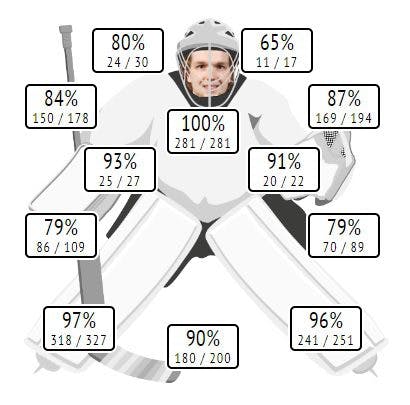Have the Toronto Maple Leafs found Andrei Vasilevskiy’s weakness?

I woke up this morning to this text from a current NHL goalie: “How wild is it that 95 percent of the goals on Vasilevskiy have been blocker side? I think the last eight straight have been.”
Yep. It is wild. And a lot of people have picked up on it. From the Game 4 ESPN broadcast crew to fans on social media, eyes are wide open that Vasilevskiy is struggling to make saves on shots to his blocker side. So I decided to take a deeper dive and see what’s actually going on with the 2021 Conn Smythe Trophy winner.
First off, a quick fact check. No, Vasilevskiy has not allowed eight straight goals blocker side: it’s been eight of the past nine. Splitting hairs. And in the first round of Stanley Cup playoff action, Vasilevskiy has allowed 11 of 19 Toronto goals to the stick side: that’s 58 percent. Not 95.
Sometimes we’re all guilty of speaking in hyperbole, but my friend’s point was made: Vasilevskiy is getting crushed on goals past the right side of his body. Especially in the past two games. And the scary part for the Lightning is that the Maple Leafs have started gunning for that area of the net.
Using InStat Hockey, I went back and tracked all of Toronto’s shots during the first four games of the series, and at first glance it doesn’t appear that the Leafs are targeting the left side of the net. 40.5 percent of the Maple Leafs’ 132 shots on goal went towards Vasilevskiy’s blocker side, 21.5 percent were in the middle of the net, and 38 percent were fired towards the Lightning netminder’s glove hand.
But there’s a difference between the first two games of the series that took place in Toronto, and the second set in Tampa Bay. In Game 1 and Game 2, The Leafs shaded heavier to Vasilevsky’s glove side; 43 percent of Toronto’s shots went toward the Tampa netminder’s left, compared to 37 percent on his stick side, and 20 percent went towards the middle of the net. All three Maple Leafs goals in Game 1 went in blocker side, while five of seven tallies went in glove side during Game 2.
But in Games 3 and 4 of the series, Toronto’s shooting habits shifted. The Leafs put 45 percent of their shots towards Vasilevskiy’s blocker side, while 32 percent went to his glove hand. The middle of the net received 23 percent of shots.
But here’s the kicker: 18 of Toronto’s high shots (above pad height) in Games 3 and 4 went blocker side, while only nine went toward the Tampa Bay netminder’s glove hand. And eight of nine goals went past Vasilevskiy’s stick side. It felt like Toronto was shooting with a purpose.
What’s interesting is that during the 2022-23 regular season, Toronto’s shots on goal were balanced. The Maple Leafs put 36 percent of shots blocker side, 29 percent middle net, and 35 percent glove side.
So are the Maple Leafs making a concerted effort to attack Vasilevskiy’s blocker side? It seems like it, at least recently. And especially on high shots. But the strange part is that, during the 2022-23 regular season, Vasilevskiy didn’t have a weakness to either side. His goals against chart was very even.

As you can see in the graphic above, over the course of the entire 2022-23 season, Vasilevskiy didn’t have a noticeably vulnerable spot. Although I do find it interesting that the Lightning netminder faced almost 100 more shots to his blocker side. Why? I’m not sure. I thought maybe teams knew something I didn’t. So I checked Vasilevskiy’s career goals against map, and it’s almost identical to his 2022-23 season. If teams were targeting his blocker side, it wasn’t paying off.
What does this all mean? First off, I don’t think it’s a coincidence that the Maple Leafs are targeting blocker side on Vasilevskiy. Toronto has some big analytic brains on the payroll. And to me, it’s pretty clear they discovered a potential weakness and passed it along to Leafs head coach Sheldon Keefe and his staff.
Here’s what I think they may have identified: Vasilevskiy has a difficult time stopping high blocker side shots, especially when traffic is present. And so far in the series, the numbers suggest targeting that area of the net is working for the Leafs.
Vasilevskiy has allowed six Toronto goals to his stick side on shots involving a screen or deflection. Only two have beaten him in a similar manner to his glove hand.
And then there’s the comments of Detroit Red Wings head coach Derek Lalonde, who spent the previous four seasons with Tampa Bay as an assistant under Lightning head coach Jon Cooper. Providing on-air analysis for Sportsnet during the Stanley Cup playoffs, Lalonde recently made some interesting remarks about his former netminder.
The Red Wings bench boss said that the Lightning did a study “back in the day” that showed Vasilevskiy was “one of the lower percentage goalies in finding pucks from the point.” What Lalonde didn’t say was how long ago that analysis took place. And if Vasilevskiy had corrected the issue.
Unsurprisingly, Cooper defended his goaltender the following day. While the Lightning coach stopped short of calling Lalonde a liar, his comments raised eyebrows. “He is trying to offer insight and give the fans something,” Cooper said after Tampa Bay’s practice Wednesday. “He should be doing that. It’s just making sure it’s accurate in what he is saying.”
Interesting. Was Cooper providing a buffer for Vasilevskiy? Or has Vasilevskiy improved since the study took place? Without further questioning, it’s hard to say. But regardless, Lalonde put Vasilevskiy on blast. At some point in his career, the Lightning netminder wasn’t very good at navigating screens in front of his crease.
So for me, here’s the challenge for the 2019 Vezina Trophy winner: can Vasilevskiy do a better job of finding windows through traffic? I think he has to. For a goaltender, stopping screened shots is dependent upon finding the puck off the shooter’s blade. Goaltenders typically cannot pick up the shot mid-flight and adapt in time. They have to see the release. And right now that’s an area of concern for Vasilevskiy.
Toronto knows what’s working and they’re bound to stick with it. Rest assured that Toronto’s game plan for Game 5 will continue to involve sending bodies to the front of the net. And if possible, lobbing the puck towards the left side of the cage.
Sometimes numbers don’t make sense. And maybe this entire exercise in data-driven analysis is an anomaly. Maybe the Leafs aren’t targeting Vasilevskiy’s blocker side. Or maybe the Lightning netminder simply hasn’t come up with the saves. It could be fluke.
But here’s one thing I’m confident of: perception becomes reality very quickly in today’s world. And right now, word is out that Vasilevskiy – the best money goaltender in the world – has a tangible weakness. Blocker side high.
I have no doubt Toronto will continue trying to exploit the two-time Stanley Cup champion’s stick side. But I also think Vasilevskiy is likely to do his homework in advance of Game 5.
May the best team win.

Discover Betano.ca – a premium Sports Betting and Online Casino experience. Offering numerous unique and dynamic betting options along with diverse digital and live casino games, Betano is where The Game Starts Now. 19+. Please play responsibly.
_____
Recently by Mike McKenna
- Why Edmonton Oilers must stick with Stuart Skinner over Jack Campbell in net for Game 5
- Why goalie tandems in the Stanley Cup playoffs might be the wave of the future
- Are the Winnipeg Jets already in the Vegas Golden Knights’ heads?
- Breaking down every Round 1 goaltending matchup in 2023 Stanley Cup playoffs
- ‘It’s horseshit. It’s not fantasy hockey.’ The ATO goalie trend is an insult to players on the NHL bubble
- Goalie confidence ratings: How sturdy is every NHL playoff contender’s crease?
- How the West will be won: Bet on the Dallas Stars to make deep playoff run
More from Mike McKenna
- Ranking every NHL goalie tandem for 2023-24
- Staring down Lou: How standing up for yourself can change a player’s career
- Why it’s time to embrace ‘gambles’ like the Jake Sanderson contract
- Why we shouldn’t view Sheldon Keefe’s contract extension as a vote of confidence
- ‘Two Sean O’Connors?’ NHL training camps bring the funny – and the weird